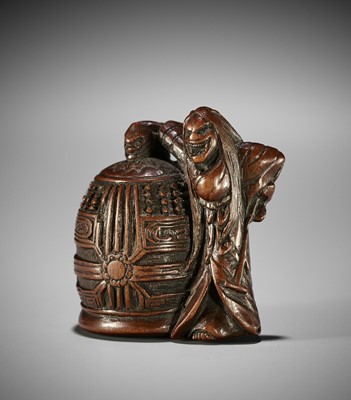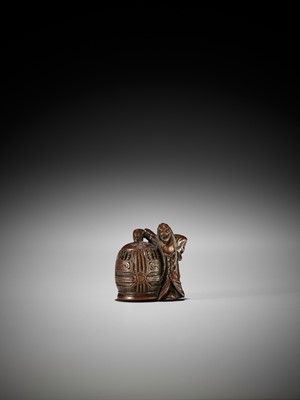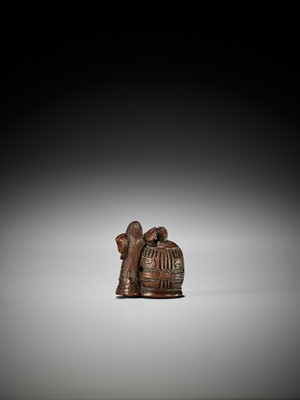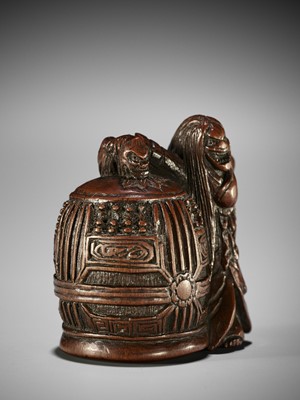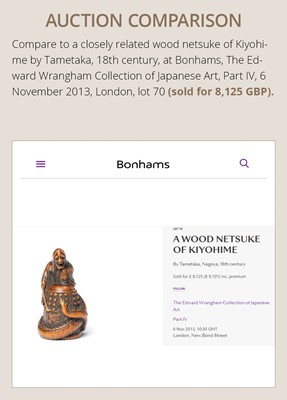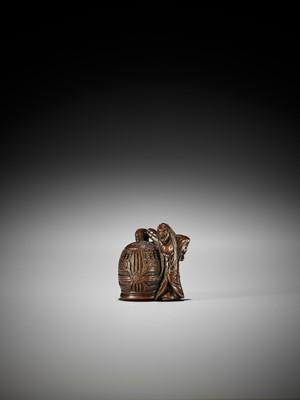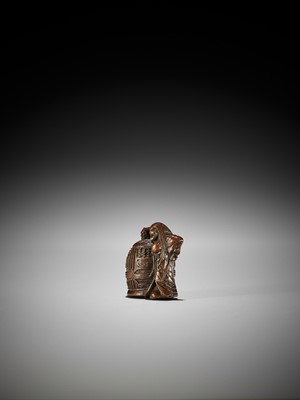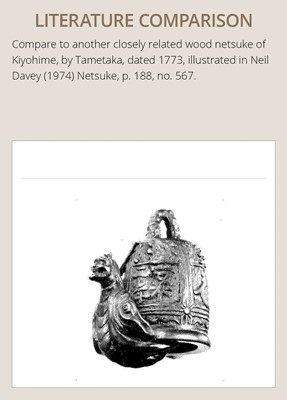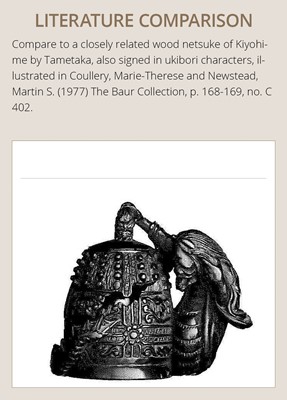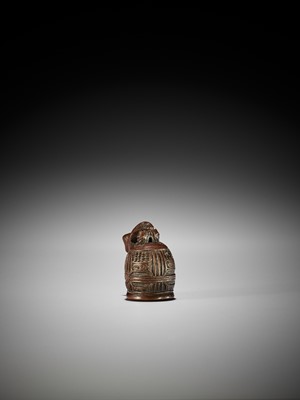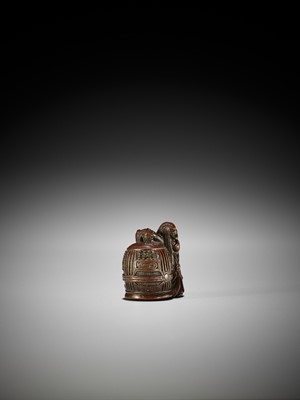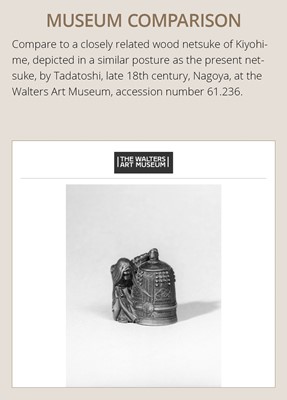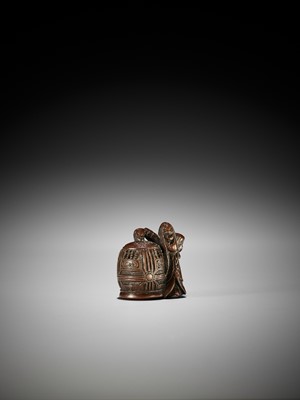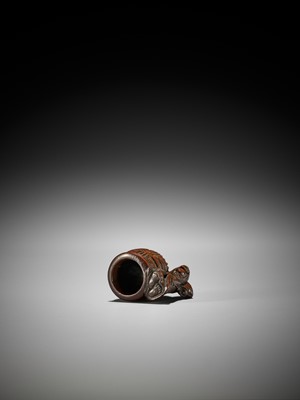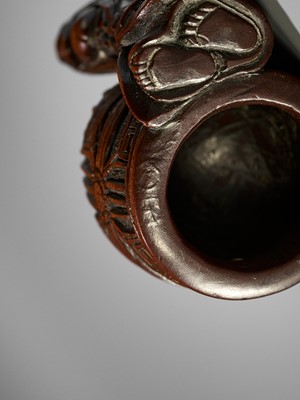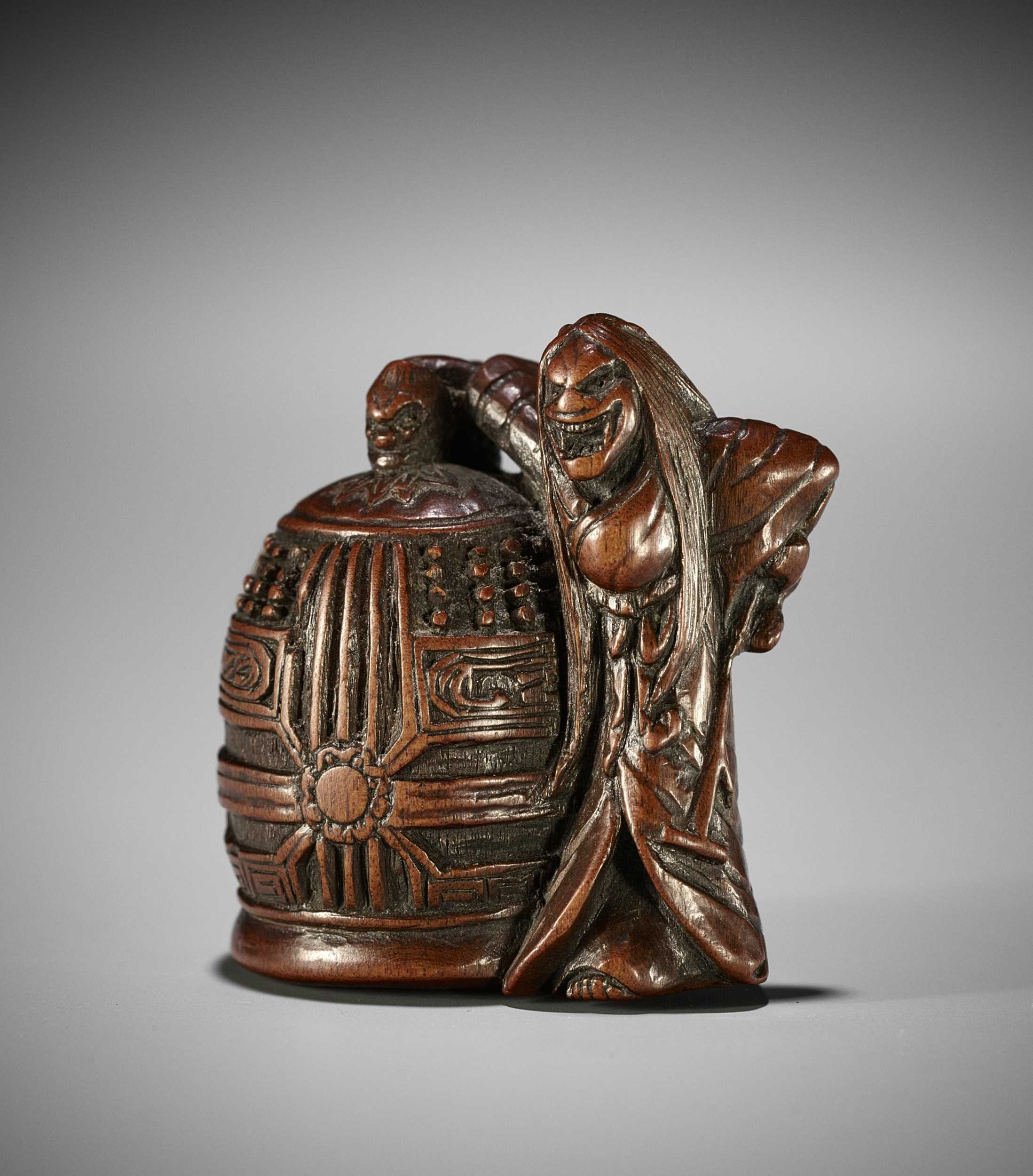4th Nov, 2022 13:00
Fine Netsuke & Sagemono
57
TAMETAKA: A RARE WOOD NETSUKE OF KIYOHIME
Sold for €6,175
Estimated at €3,000 - €6,000
including Buyer's Premium
By Tametaka, signed Tametaka 為隆
Japan, Nagoya, late 18th century, Edo period (1615-1868)
Kiyohime is depicted in humanoid form, rather than as a serpentine monster, standing next to a Buddhist temple bell and holding a striker in her hand, her face with a triumphantly smug expression as she succeeded in her endeavors, casually leaning against the handle of the temple bell, which is finely engraved with bosses, key-fret, floral medallions, and surmounted by a double-dragon head handle. The expression is superbly carved and imbued with Tametaka’s idiosyncratic humor, the details are boldly carved, and the reddish cherry wood bears a fine, typical patina. Himotoshi through the bell and signed in partially worn ukibori characters TAMETAKA at the rim of the bell.
HEIGHT 4 cm
Condition: Very good condition, minor wear, light surface scratches.
Provenance: European collection.
Tametaka is the earliest recorded netsuke artist from Nagoya and is listed in the Soken Kisho, the first publication on netsuke published in 1781. He is credited with the invention of the relief-carving technique (ukibori) associated with the Nagoya school. Kiyohime appears to be a favored subject, depicted in various stages of the story and each one carved in a different manner, yet still retaining the idiosyncratic style of this celebrated artist.
In this story, Kyohime fell in love with a Buddhist monk named Anchin but was rejected. In despair she pursues the monk and transforms herself into a Hannya-like demon with a snake body and horned head. The pursued Anchin hides under a temple bell. When she discovers him there, she wraps her snake body around the bell and the glow of her passion melts the metal and burns the monk hiding in the bell.
Literature comparison:
Compare to a closely related wood netsuke of Kiyohime by Tametaka, also signed in ukibori characters, illustrated in Coullery, Marie-Therese and Newstead, Martin S. (1977) The Baur Collection, p. 168-169, no. C 402. Compare also to another closely related wood netsuke of Kiyohime, by Tametaka, dated 1773, illustrated in Neil Davey (1974) Netsuke, p. 188, no. 567.
Museum comparison:
Compare to a closely related wood netsuke of Kiyohime, depicted in a similar posture as the present netsuke, by Tadatoshi, late 18th century, Nagoya, at the Walters Art Museum, accession number 61.236.
Auction comparison:
Compare to a closely related wood netsuke of Kiyohime by Tametaka, 18th century, at Bonhams, The Edward Wrangham Collection of Japanese Art, Part IV, 6 November 2013, London, lot 70 (sold for 8,125 GBP).
By Tametaka, signed Tametaka 為隆
Japan, Nagoya, late 18th century, Edo period (1615-1868)
Kiyohime is depicted in humanoid form, rather than as a serpentine monster, standing next to a Buddhist temple bell and holding a striker in her hand, her face with a triumphantly smug expression as she succeeded in her endeavors, casually leaning against the handle of the temple bell, which is finely engraved with bosses, key-fret, floral medallions, and surmounted by a double-dragon head handle. The expression is superbly carved and imbued with Tametaka’s idiosyncratic humor, the details are boldly carved, and the reddish cherry wood bears a fine, typical patina. Himotoshi through the bell and signed in partially worn ukibori characters TAMETAKA at the rim of the bell.
HEIGHT 4 cm
Condition: Very good condition, minor wear, light surface scratches.
Provenance: European collection.
Tametaka is the earliest recorded netsuke artist from Nagoya and is listed in the Soken Kisho, the first publication on netsuke published in 1781. He is credited with the invention of the relief-carving technique (ukibori) associated with the Nagoya school. Kiyohime appears to be a favored subject, depicted in various stages of the story and each one carved in a different manner, yet still retaining the idiosyncratic style of this celebrated artist.
In this story, Kyohime fell in love with a Buddhist monk named Anchin but was rejected. In despair she pursues the monk and transforms herself into a Hannya-like demon with a snake body and horned head. The pursued Anchin hides under a temple bell. When she discovers him there, she wraps her snake body around the bell and the glow of her passion melts the metal and burns the monk hiding in the bell.
Literature comparison:
Compare to a closely related wood netsuke of Kiyohime by Tametaka, also signed in ukibori characters, illustrated in Coullery, Marie-Therese and Newstead, Martin S. (1977) The Baur Collection, p. 168-169, no. C 402. Compare also to another closely related wood netsuke of Kiyohime, by Tametaka, dated 1773, illustrated in Neil Davey (1974) Netsuke, p. 188, no. 567.
Museum comparison:
Compare to a closely related wood netsuke of Kiyohime, depicted in a similar posture as the present netsuke, by Tadatoshi, late 18th century, Nagoya, at the Walters Art Museum, accession number 61.236.
Auction comparison:
Compare to a closely related wood netsuke of Kiyohime by Tametaka, 18th century, at Bonhams, The Edward Wrangham Collection of Japanese Art, Part IV, 6 November 2013, London, lot 70 (sold for 8,125 GBP).
Zacke Live Online Bidding
Our online bidding platform makes it easier than ever to bid in our auctions! When you bid through our website, you can take advantage of our premium buyer's terms without incurring any additional online bidding surcharges.
To bid live online, you'll need to create an online account. Once your account is created and your identity is verified, you can register to bid in an auction up to 12 hours before the auction begins.
Intended Spend and Bid Limits
When you register to bid in an online auction, you will need to share your intended maximum spending budget for the auction. We will then review your intended spend and set a bid limit for you. Once you have pre-registered for a live online auction, you can see your intended spend and bid limit by going to 'Account Settings' and clicking on 'Live Bidding Registrations'.
Your bid limit will be the maximum amount you can bid during the auction. Your bid limit is for the hammer price and is not affected by the buyer’s premium and VAT. For example, if you have a bid limit of €1,000 and place two winning bids for €300 and €200, then you will only be able to bid €500 for the rest of the auction. If you try to place a bid that is higher than €500, you will not be able to do so.
Online Absentee and Telephone Bids
You can now leave absentee and telephone bids on our website!
Absentee Bidding
Once you've created an account and your identity is verified, you can leave your absentee bid directly on the lot page. We will contact you when your bids have been confirmed.
Telephone Bidding
Once you've created an account and your identity is verified, you can leave telephone bids online. We will contact you when your bids have been confirmed.
Classic Absentee and Telephone Bidding Form
You can still submit absentee and telephone bids by email or fax if you prefer. Simply fill out the Absentee Bidding/Telephone bidding form and return it to us by email at office@zacke.at or by fax at +43 (1) 532 04 52 20. You can download the PDF from our Upcoming Auctions page.
How-To Guides
How to Create Your Personal Zacke Account
How to Register to Bid on Zacke Live
How to Leave Absentee Bids Online
How to Leave Telephone Bids Online
中文版本的操作指南
创建新账号
注册Zacke Live在线直播竞拍(免平台费)
缺席投标和电话投标
Third-Party Bidding
We partner with best-in-class third-party partners to make it easy for you to bid online in the channel of your choice. Please note that if you bid with one of our third-party online partners, then there will be a live bidding surcharge on top of your final purchase price. You can find all of our fees here. Here's a full list of our third-party partners:
- 51 Bid Live
- EpaiLive
- ArtFoxLive
- Invaluable
- LiveAuctioneers
- the-saleroom
- lot-tissimo
- Drouot
Please note that we place different auctions on different platforms. For example, in general, we only place Chinese art auctions on 51 Bid Live.
Bidding in Person
You must register to bid in person and will be assigned a paddle at the auction. Please contact us at office@zacke.at or +43 (1) 532 04 52 for the latest local health and safety guidelines.
